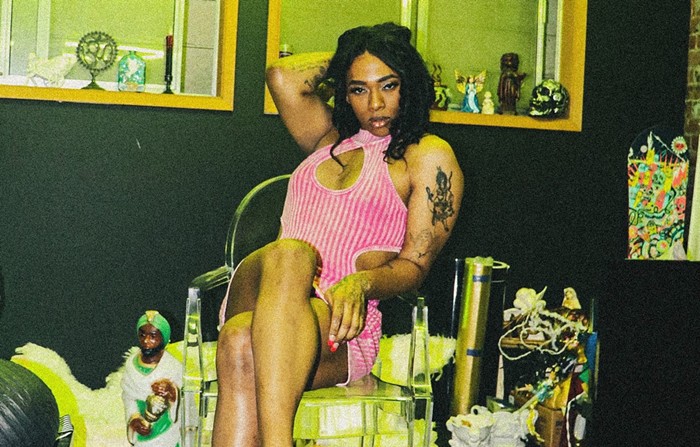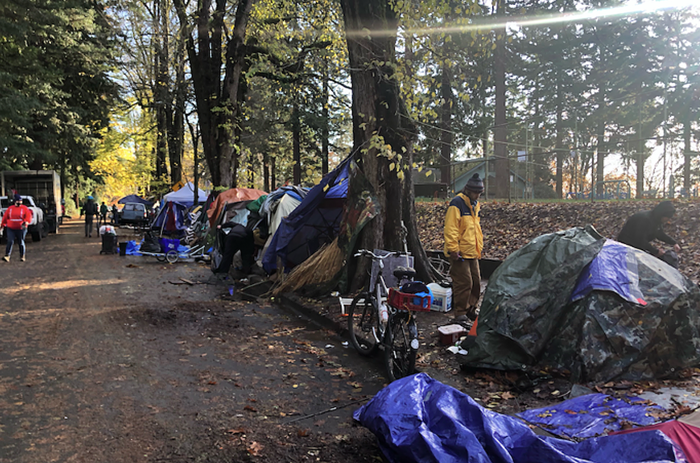THREE EIGHT-FOOT-TALL glowing heads sit on a square pile of smooth marble stones, their faces marked with words in relief. One face's forehead reads "Ignorance," with "Wrath" on one cheek and "Desire" on the other. Bruce Guenther, the Portland Art Museum's (PAM) chief curator, envisioned this big experience (Jaume Plensa's "In the Midst of Dreams") as the capital letter to his latest creation, Disquieted, but it's only the beginning.
In Charles Ray's "Fall '91," a nine-foot-tall mannequin, hands on hips and clad in a power suit, stands aggressively above the viewer. A few steps away is "Noses & Ears, Etc. (Part Three): Altered Person with Descending Hand" by John Baldessari, a grainy photo of a gloved hand reaching for a woman's face. As it's uncertain whether the woman is in a moment of pleasure or pain, and whether the gloved hand is descending to help or harm, the image's ambiguity is a bit jarring. This unsettling quality is exactly what Guenther's going for.
Via the work of 28 living artists, Guenther says Disquieted aims to disgust, horrify, and amuse, challenging our sense of "gender, identity, society, and economics" by exposing us to uncomfortable modern-day realities.
Disquieted certainly does have its unsettling moments—pieces which seem to guarantee a challenge to the consciousness of Western audiences. As evidence, two photos by Andreas Gursky: "Greeley" shows cattle in an industrial pasture from an aerial view, the animals spreading for miles into the distance; "Nha Trang, Vietnam" is another aerial shot, this time recording hundreds if not thousands of women weaving in a gloaming warehouse. The most eerie aspect of these photos is their similarity in perspective, and the treatment of the subjects—both cattle and women en masse, identity-stripped from a bird's eye view, appear more as a pattern than living things.
Some of the works on display, though, might require the viewer to bring their own preconceived notions of a disquieted psyche in order to connect to the overall theme. Takashi Murakami's "Hustle 'n' Punch by Kaikai and Kiki" shows thousands of graphical, smiley flowers over a 10-foot by 20-foot canvas—some of these cuddly flowers open their mouths to expose fangs. Rather than disquieting, this image felt playful and somewhat sarcastic. "Warp," the second Murakami on view, is almost entirely abstract, eroded, and pattern based, and I doubt that any irrefutable argument could be made as to what emotion is being called forth.
Ultimately, the strength of the show is found in the works on display, rather than a perfectly cohesive overall theme—after all, what disquiets one viewer makes another laugh, or feel at home, or fill with any other emotion a human being might have. And while the thematic success of the show is ultimately up to the viewer, the works themselves are strong.
A major plus to Disquieted: There're no cheesy participatory aspects, like the digital tattoo booth from Marking Portland, PAM's tattoo exhibit. Replacing the kitsch is a Disquieted iPhone app, providing basic museum info, exhibition maps, and videos of the featured artists (and others) discussing their work. According to Guenther, the videos are designed to provide various perspectives on the works while avoiding a prescribed opinion. Unfortunately, the app wasn't ready for use at the time of the Disquieted press preview, though it's currently available through Apple's App Store for $2.99 (and iPhone-less folks won't be left out—PAM has 50 iPod Touches available for rental, pre-loaded with the app).













